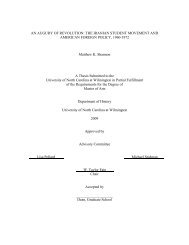Saprolegnia - The iLumina Digital Library
Saprolegnia - The iLumina Digital Library
Saprolegnia - The iLumina Digital Library
Create successful ePaper yourself
Turn your PDF publications into a flip-book with our unique Google optimized e-Paper software.
<strong>Saprolegnia</strong> lapponica Gäumann, ibid., p. 156. 1918.<br />
<strong>Saprolegnia</strong> tokugawana Emoto, Bot. Mag. (Tokyo) 37:15, pl. 1. 1923.<br />
<strong>Saprolegnia</strong> monoica var. floccosa (Maurizio) Cejp, Oomycetes I, Flora ČSR, Ser. B, Part 2,<br />
p. 234, figs. 85 g-j, 86. 1959.<br />
<strong>Saprolegnia</strong> ferax var. lapponica (Gäumann) Cejp, ibid., p. 245. 1959.<br />
<strong>Saprolegnia</strong> ferax var. esocina (Maurizio) Cejp, ibid., p. 246. 1959.<br />
<strong>Saprolegnia</strong> monoica var. acidamica Suzuki, J. Jap. Bot., 36:234. 1961.<br />
Monoecious. Mycelium stout, hyphae moderately to sparingly branched.<br />
Sporangia clavate, fusiform, cylindrical, or slightly irregular, sometimes nearly<br />
spherical; straight or bent; renewed internally with secondary ones nesting inside<br />
discharged primary ones, or partially emerged through orifices of empty sporangia and<br />
forming bead-like chains or cylindrical segments, or emerging fully through orifices of<br />
previously emptied sporangia; rarely renewed in a basipetalous or cymose manner; 31-<br />
624 x 18-67 µm. Spores dimorphic; discharge and behavior saprolegnoid, rarely<br />
aplanoid or dictyucoid, very rarely achlyoid or leptolegnoid; primary spore cysts 9-12<br />
µm in diameter. Gemmae, when present, variable in shape and position. Oogonia<br />
lateral, terminal, or intercalary and then single or catenulate, infrequently occurring in<br />
emptied sporangia or sessile; spherical, obpyriform, napiform, sometimes obovate or<br />
clavate, cylindrical when in discharged sporangia, often dolioform when intercalary;<br />
(28-) 60-80 (-194) µm in diameter. Oogonial wall generally conspicuously and<br />
abundantly pitted, rarely unpitted; smooth or rarely with one or two short, papilliform<br />
evaginations, or apiculate. Oogonial stalks ( 1 / 3 -) 1-2 (3 1 / 2 ) times the diameter of the<br />
oogonium, in length; stout, straight, bent, or curved; very rarely once-branched.<br />
Oospores centric or subcentric, spherical or ellipsoidal; (1-) 10-18 (-54) per oogonium<br />
and nearly filling it, (12-) 22-28 (-44) µm in diameter; germinating by a slender germ<br />
hypha that may or may not bear a small, apical, clavate sporangium. Antheridial<br />
branches variable in abundance and density, and sometimes absent; when present,<br />
monoclinous or androgynous, rarely diclinous; slender, slightly to prominently<br />
irregular, unbranched or very sparingly branched; persisting. Antheridial cells simple;<br />
generally tubular or clavate, occasionally irregular, infrequently once-branched; usually<br />
persisting; laterally appressed, very rarely attached apically; fertilization tubes present,<br />
not persisting.<br />
Based on a survey of existing literature and the characterization of a generous<br />
collection of living material, Seymour (1970) demonstrated that <strong>Saprolegnia</strong> ferax was a<br />
complex of morphological variants. Many of the various forms that had from time to<br />
time been described, he concluded, were recognizable as individuals, but at the same<br />
time occupied some point in a long series of morphological gradients. Accordingly, he<br />
proposed a very extensive synonymy (Seymour, 1970:29, 30) for S. ferax; this is adopted<br />
here with minor corrections. Discussion of the synonymous species beyond that<br />
provided by Seymour is unnecessary. Florinskaya (1968) has also studied extensively<br />
the degree of morphological variability in S. ferax, particularly that to be found in<br />
620
















